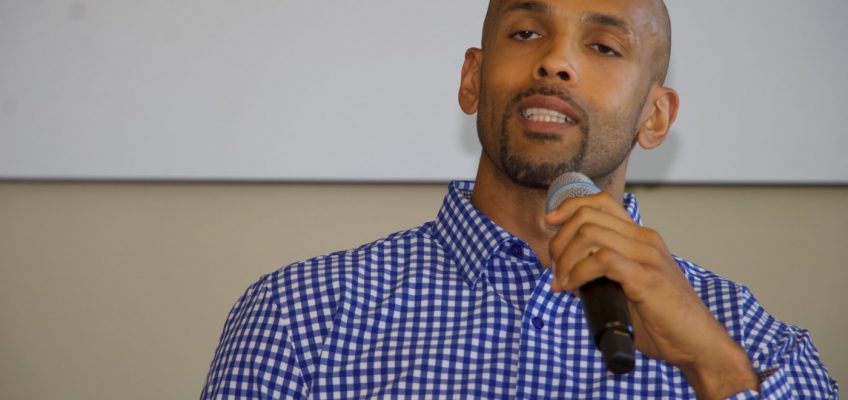Darnell Cox started using marijuana and alcohol around the age of 12. By 20 he had been introduced to hard drugs. His uncle had been released from prison, and Cox started spending time with him and his friends. That’s how he became addicted to methamphetamine.
Cox is one of many Americans whose entire family systems are affected by substance-use disorder. About 1 in 4 U.S. children lived with at least one parent or caretaker with substance-use disorder in 2023, according to research from the National Institute of Health.
In 2020, Cox had found recovery, but it was fragile. He was two years sober, working for the first time in construction. He and his family had created distance from unhealthy people and behaviors.
Darnell Cox, pictured here in high school, began using drugs at age 12. After struggling with addiction for years, he has found belonging and community to be key to his recovery. (Photo courtesy Darnell Cox)
Then the COVID-19 pandemic hit. It was an isolating time for everyone, and substance-use disorders surged. Cox started using again and quickly spiraled.
“I was living in my car, fully prepared to go back to prison when they caught me using meth again,” he said. “I couldn’t stop until I was in jail. When I was in jail, I was away from it, I could come down. That’s how jails and prisons almost became a reset for me.”
When he was caught, the judge gave him another shot, and that’s when he found Minnesota Recovery Connection. Now, he is the director of operations there.
The key to his recovery? “The difference between this time and the last is actually finding that connection and finding that place where I belong,” he said.
Doing things differently got Cox out of the cycle. He learned new hobbies during his time in prison. He learned how to crochet so he could make things for his kids. He now regularly enjoys crocheting and even has a TikTok page at @yarnellcrochet showcasing his art. He also replaced his criminal habits with a health and fitness routine. He goes to the gym daily and plays basketball with a group weekly.
“I reset many times; the big part of it was I never realized, until the last time, that after I reset I needed to do something different,” he said.
People recovering from addiction need support and community as they walk their roads to healing.
A student, M, who requested anonymity because of the stigma surrounding substance-use disorder, struggled with addiction at his large suburban high school in Plymouth.
Vaping was his gateway to addiction. He was 13 and influenced by peers at his high school. It escalated from there. M struggled for years and was not able to find the support he needed within the school’s community.
“There was no real safe space, because I felt whatever I told them they were going to tell other people. It was hard to quit when all they would do is take you to the office and get you in trouble and make you do some program, but that’s not really helping students,” he said.
M eventually left his high school for a private Christian alternative. He originally had no intentions of turning his life around, but his new environment influenced him to stop using substances and engage in more productive behavior.
“Just the conversations and experiences I had in my private school really changed the way I was viewing the things I did. I felt I could have real talks with the teachers and not be judged, because they weren’t perfect people either, but they made me feel seen,” he said.
Chemical health and recovery specialists are important leaders to have in schools today, says Cynthia Munguia, executive director for Minnesota Recovery Connection. Munguia and M agree: they positively affect the community to be a more safe and accepting place, so students have someone that they can speak to without fear of getting in trouble.
“Absolutely develop support programs for students, collegiate programs for substance-use disorders or recovery-oriented programs providing understanding and education,” said Munguia.
“I think (schools) should lead with programs; you keep taking away a kid’s vape then he’s just going to get a new one. Actually tackle the issue; they can actually give kids the help they need to quit,” said M. He stressed the importance of focusing on why young people are using.
Cox, Munguia, and M agree that a strong, supportive community is essential to a successful recovery. It can affect whether an individual starts using substances and it can affect whether they are able to stop and sustain recovery.
Munguia wants struggling young people – like a younger M or Cox – to know that help is available.
“I would really love our young generation to know that they’re not alone,” she said. “They’re not the first ones or the last. It’s wonderful to be able to reach out to someone, especially when you’re feeling alone, that you know there’s one person who can listen to your story and help you.”
Additional reporting by Smit Bhardwaj and Alaia Scroggins (Wayzata High School)
About this report
This story was produced as part of ThreeSixty Journalism’s Multimedia Storytelling Institute for high school students in partnership with Blue Cross and Blue Shield of Minnesota, which financially sponsors the camp and supports story sourcing. ThreeSixty Journalism is a multimedia storytelling program for Minnesota youth. Grounded in the principles of journalism and focused on contributing to more accurate narratives and representative newsrooms, ThreeSixty offers technical, ethical, and entrepreneurial training for fulfilling careers in storytelling and civic leadership. It has been housed at the College of Arts and Sciences at the University of St. Thomas since 2001.


Leave a Reply